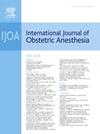Predictors of repeat epidural blood patch for postdural puncture headache after labor epidural analgesia: a single-center retrospective cohort study (2014–2024)
IF 2.3
3区 医学
Q2 ANESTHESIOLOGY
引用次数: 0
Abstract
Background
Epidural blood patch remains the gold standard for treating postdural puncture headache following unintentional dural puncture during labor epidural analgesia. However, epidural blood patch may fail in 17–28 % of cases, necessitating repeat procedures. Factors predicting epidural blood patch failure remain poorly understood, limiting the ability to optimize treatment strategies. We aimed to identify independent predictors of repeat epidural blood patch following postdural puncture headache.
Methods
We conducted a retrospective observational study at a tertiary maternity center from January 2014 to December 2024. All obstetric patients receiving an epidural blood patch following labor epidural analgesia were included. Demographic, clinical, and procedural variables were analyzed to identify independent predictors of repeat epidural blood patch using multivariable logistic regression. The primary outcome was the need for more than one epidural blood patch to achieve symptom resolution.
Results
Among 142 included patients, 39 (27.5 %) required repeat epidural blood patch procedures. Multivariable analysis identified two independent predictors of repeat EBP: earlier timing of first blood patch (OR 0.441 per day delay, 95 % CI 0.270 to 0.721, P = 0.001) and shallower epidural space depth (OR 0.687 per cm, 95 % CI 0.493 to 0.958, P = 0.027). Sensitivity analysis confirmed that EBP performed within 24 h (OR 4.740) and within 48 h (OR 3.689) was associated with significantly higher failure rates. Patients requiring repeat procedures had significantly longer hospital stays (median 5 vs. 4 days, P < 0.001).
Conclusions
Early epidural blood patch administration (≤48 h) and shallow epidural space depth were independently associated with treatment failure. These associations may reflect confounding by indication and require further validation.
重复硬膜外血贴治疗分娩后硬膜穿刺头痛的预测因素:单中心回顾性队列研究(2014-2024)
背景:硬膜外血贴仍然是治疗分娩过程中意外硬膜穿刺后硬膜后头痛的金标准。然而,硬膜外补血可能在17 - 28%的病例中失败,需要重复手术。预测硬膜外血贴失败的因素仍然知之甚少,限制了优化治疗策略的能力。我们的目的是确定独立的预测因素重复硬膜外血贴片后硬脊膜穿刺头痛。方法于2014年1月至2024年12月在某三级妇产中心进行回顾性观察研究。所有在分娩后硬膜外镇痛后接受硬膜外血液贴片的产科患者均被纳入研究。采用多变量logistic回归分析人口统计学、临床和程序变量,以确定重复硬膜外血贴片的独立预测因素。主要结果是需要一个以上的硬膜外血液贴片来达到症状缓解。结果142例患者中,39例(27.5%)需要重复硬膜外补血。多变量分析确定了重复EBP的两个独立预测因素:第一次补血时间较早(OR 0.441 / d, 95% CI 0.270 ~ 0.721, P = 0.001)和硬膜外腔深度较浅(OR 0.687 / cm, 95% CI 0.493 ~ 0.958, P = 0.027)。敏感性分析证实,24小时内(OR 4.740)和48小时内(OR 3.689)进行EBP的失败率明显较高。需要重复手术的患者住院时间明显延长(中位5天vs. 4天,P < 0.001)。结论早期硬膜外补血(≤48 h)和浅硬膜外间隙深度与治疗失败独立相关。这些关联可能反映了适应症的混淆,需要进一步验证。
本文章由计算机程序翻译,如有差异,请以英文原文为准。
求助全文
约1分钟内获得全文
求助全文
来源期刊
CiteScore
4.70
自引率
7.10%
发文量
285
审稿时长
58 days
期刊介绍:
The International Journal of Obstetric Anesthesia is the only journal publishing original articles devoted exclusively to obstetric anesthesia and bringing together all three of its principal components; anesthesia care for operative delivery and the perioperative period, pain relief in labour and care of the critically ill obstetric patient.
• Original research (both clinical and laboratory), short reports and case reports will be considered.
• The journal also publishes invited review articles and debates on topical and controversial subjects in the area of obstetric anesthesia.
• Articles on related topics such as perinatal physiology and pharmacology and all subjects of importance to obstetric anaesthetists/anesthesiologists are also welcome.
The journal is peer-reviewed by international experts. Scholarship is stressed to include the focus on discovery, application of knowledge across fields, and informing the medical community. Through the peer-review process, we hope to attest to the quality of scholarships and guide the Journal to extend and transform knowledge in this important and expanding area.

 求助内容:
求助内容: 应助结果提醒方式:
应助结果提醒方式:


